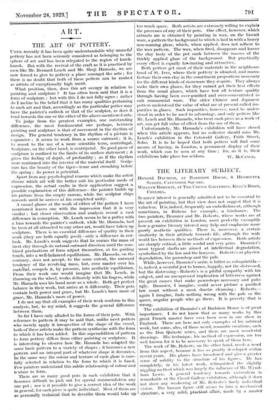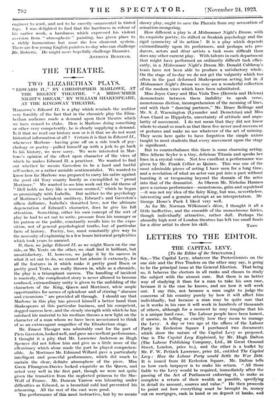THE LITERARY SUBJ ECT.
HONORk DAUMIER, AT BARBIZON HOUSE, 8 HENRIETTA STREET, CAVENDISH SQUARE.
WILLIAM ROBERTS, AT THE CHENIL GALLERIES, KING'S ROAD, CHELSEA.
SUBJECT interest is generally admitted not to be essential to the art of painting, but that view does not suggest that it is valueless. It is, indeed, frequently an embellishment, although sometimes, in Rubens for example, a hindrance. The two painters, Daumier and Mr. Roberts, whose works arc ut present on exhibition in London, most perfectly exemplify how a genuine literary interest may help and emphasize more purely aesthetic qualities. There is, moreover, a certain similarity in their attitude towards life, although the wide world lies between their methods of expression. Both artists are sharply critical, a little sordid and very grim. Daumier's most typical shafts are aimed at intellectual degradation, symbolized by the law and the lawyers. Roberts's at physfca degradation, the pawnshop and the pub.
While, however, Daumicr's satire is bitter as coloquintida- is, indeed, a scornful jest to harass, happily, not the distressed, but the distressing—Roberts's is a pitiful sympathy with his subject, and an unexpressed implication of bitterness against the great causes that make pawnshops necessary and pubs ugly. Daumier, I imagine, could never picture a purified law court without a most drastic cleansing ; Roberts— again I imagine, finds nothing wrong with the pub or the queer, angular people who go there. It is poverty that is wrong.
The exhibition of Daumier's at Barbizon House is of great importance. I do not know that so many works by this great French master have ever been seen in one show in England. There are here not only examples of his satirical work, but some, also, of those weird, romantic creations, such as the Don Quixote series, and there are most wonderful drawings. His technique, his method of expression, are too well known for it to be necessary to speak of them here.
The work of Mr. Roberts, on the other hand, needs a word from this aspect, because it has so greatly developed within recent years. His planes have broadened and give a greater sense of solidity to the structure of his figures. lie has completely, in his latest work, relinquished the slightly niggling method which was largely the influence of Mr. Wynd- ham Lewis. A general tendency towards naturalism is remarkable at the Chcnil Gallery exhibition, although it does not show any weakening of Mr. Roberts's finely individual vision. The human figure still seems to him a mechanical structure, a very solid, practical affair, made by a master engineer to work, and not to be sweetly ornamental in tinted fogs. I was delighted to find that the harshness in colour of his earlier work, a harshness which expressed his violent aversion from " atmospheric " painting, has given place to it richly harmonious but none the less clear-cut system. There arc few young English painters to-day who can challenge Mr. Roberts. He might more hopefully challenge Daumier.
ANTHONY BERTRAM.



















































 Previous page
Previous page